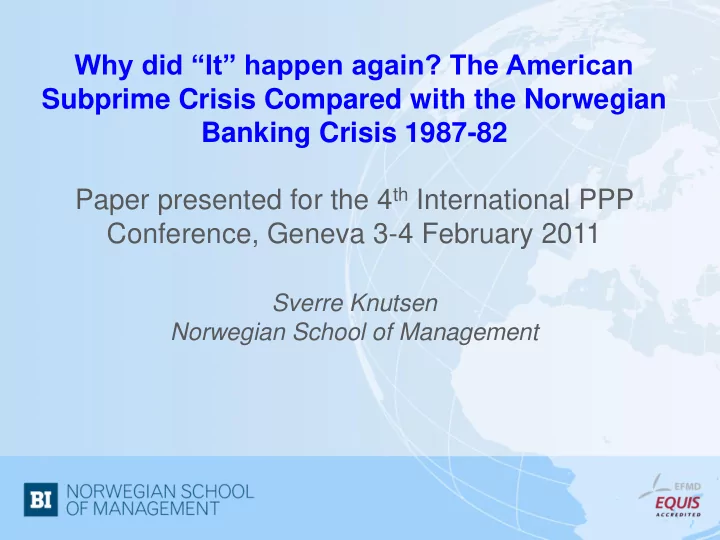

Why did “It” happen again? The American Subprime Crisis Compared with the Norwegian Banking Crisis 1987-82 Paper presented for the 4 th International PPP Conference, Geneva 3-4 February 2011 Sverre Knutsen Norwegian School of Management
Why did “It” happen again? The American Subprime Crisis Compared with the Norwegian Banking Crisis 1987-82 • The purpose of my paper is the describe and analyse the causes of banking crises • And more specifically: Which causal factors can be identified as crucial for building up of financial imbalances to such an extent that they trigger a systemic banking crisis? • To answer the question I study two cases that are different in many ways, but have experienced systemic banking crises 2
Why did “It” happen again? The American Subprime Crisis Compared with the Norwegian Banking Crisis 1987-82 • I hope the analysis of the cases reveal common patterns • However, it is important to realize that each banking crisis in history also has unique features • Moreover, it has to be emphasized that financial crises are complex processes, and that the search for mono-causal explanations will not work 3
Why did “It” happen again? The American Subprime Crisis Compared with the Norwegian Banking Crisis 1987-82 • In his “Essays on Instability and Finance”, from 1982, Hyman P. Minsky asked: Can “It” Happen Again? • “It” – that is a systemic financial crisis subsequently causing a deep economic depression • Up until the late 1980s the conventional wisdom among Norwegian economists and policymakers that “It” “couldn't happen here”. 4
Why did “It” happen again? The American Subprime Crisis Compared with the Norwegian Banking Crisis 1987-82 • Robert E. Lucas in his "presidential address to the American Economic Association”, 10 th of January 2003: “My thesis in this lecture is that macroeconomics in this original sense has succeeded: Its central problem of depression- prevention has been solved, for all practical purposes, and has in fact been solved for many decades.” • Hence, Lucas obviously excluded the possibility that “It” could happen again in the USA • Obviously, they were all wrong. 5
Why did “It” happen again? The American Subprime Crisis Compared with the Norwegian Banking Crisis 1987-82 • In my paper I have chosen a theoretical and analytical framework from Hyman Minsky – in particular his “Financial Instability Hypothesis” • Minsky’s theory is an attempt to a fully endogenous explanation of the causes of financial crises. • Minsky mainly generalises upon experiences from post-war USA 6
Why did “It” happen again? The American Subprime Crisis Compared with the Norwegian Banking Crisis 1987-82 • “ Within the neoclassical synthesis a serious depression cannot occur as a result of internal operations of the economy. In this theory a serious depression can only be result of policy errors or non-essential institutional flaws” (Minsky) • A capitalist economy is inherently unstable and crisis prone – Financial system is vital to dynamism in a capitalist economy – Driven by innovations and search for profit – M makes a distinction between three types of financial positions: hedge, speculative and Ponzi 7
Why did “It” happen again? The American Subprime Crisis Compared with the Norwegian Banking Crisis 1987-82 • The basic Minsky cycle • Over the business cycle and especially during a period of boom and prosperity, the financial structure of a capitalist economy become more and more fragile • It is the mix of the different financial positions that eventually trigger a financial crisis 8
Why did “It” happen again? The American Subprime Crisis Compared with the Norwegian Banking Crisis 1987-82 • The Minsky super cycle • The institutions of capitalism are vital to stabilize the economy. However, the actors continuously press to alter the rules of the game and change the institutional and regulatory framework • Thus, there is a long-term deterioration of the major stabilizing institutions, finally bringing about a new regulatory regime 9
Comparison Hyman Minsky: “...there are as many varieties of capitalism as Heinz has pickles.” NO US Economy Small,open World’s largest High GDP per head High GDP per head Income spread: Income spread: egalitarian non-egalitarian Political system Parliamentary Presidential Supervisory system In transition from Fragmented fragmented to integrated (from 1986) Banking structure Universal banks, Specialized Nationswide branch- Fragmented, banking from late 1960s Radical change after 1980 10
Comparison NO US Financial system Bank based Market based characteristics 11
Comparison NO US Financialization Y Y Safety-net Y Y Regulations (legislation) Tight More lax Liberalization after 1975, Liberalization after 1980 Extensive de-reg. 1983-87 Extensive de-reg. From late 1990s Financial innovations Y Y Funding characteristics Increased share of short- Increased share of short- during run-up to crisis term debt term debt Steep increase in corporate Y Y and household debt 12
Comparison NO US Asset price inflation Y (stock market and Y (housing bubble) housing/real estate bubbles) Substantial capital inflow Y Y Wages/salaries to GDP Preceded by decreasing Preceded by decreasing w/GDP ratios w/GDP ratios Consumption maintained Consumption maintained by increased debt by increased debt 13
Recommend
More recommend